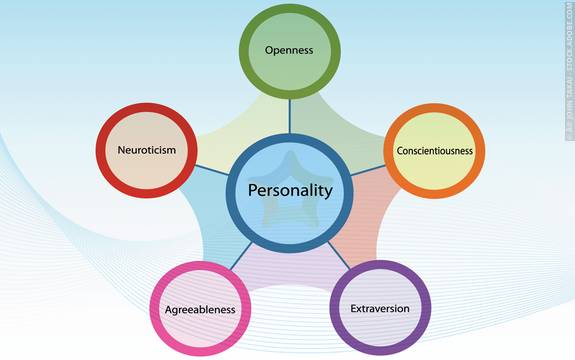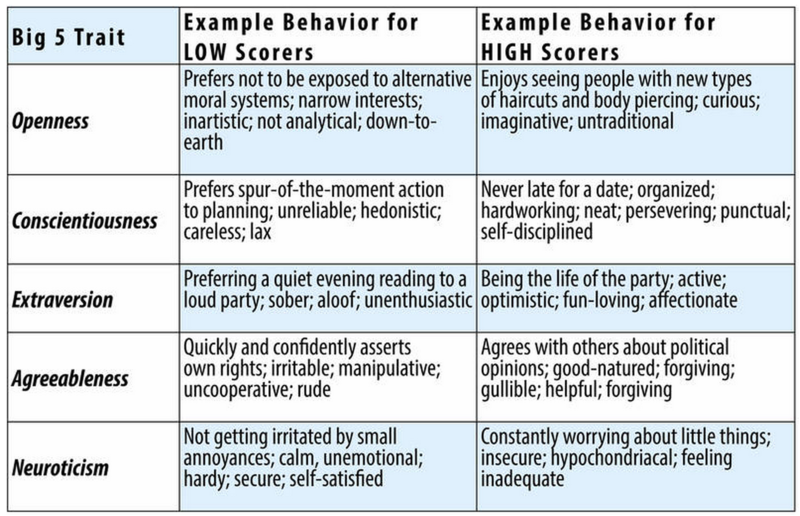The Five-factor Model of Personality Describes Personality in Terms of
The Five-Factor Model of personality describes the personality trait of an individual depending on their openness conscientiousness extraversion agreeableness and neuroticism to determine whether the person would be a highly effective leader or a less effective leader. Extraversion introversion psychoticism agreeableness and conscientiousness.

Five Factor Model Of Personality Psychologist World
-How friendly nuturing and caring compared to being cold indifferent spiteful or self centred.

. The traits include neuroticism conscientiousness agreeableness openness and extraversion. Shywithdrawn anxiousfearful and dangerousinconsistent c. The five-factor model of personality FFM is a set of five personality trait dimensions often referred to as the Big Five.
Costa McCraes Five factor theory five factor traits are seen as psychological physiological sttructure that everyone has - proposes traits have a biological basis and behavioral differences are saidto be determined by genetic influences on neural structures brain chemistry and so on. Extraversion Agreeableness Conscientiousness Neuroticism and. The five-factor model of personality describes personality in terms of.
The Big Five include emotional stability extraversion agreeableness dependability and openness to experience. -musek and colleagues developed this theory in which alpha reflects emotional stability toward positive relationships with others beta reflects flexibility toward lifes challenges changes and demands. Neuroticism extraversion openness to experience agreeableness and conscientiousness.
Five-the five-factor theory of Personality Robert R. This theory uses descriptors of common language and therefore suggests five broad dimensions commonly used to. Extraversion emotional stability openness.
Personality from this perspective is viewed to encompass alpha and beta factors. Shywithdrawn dramaticemotional and bizarrethought disordered d. The Hogan Personality Inventory.
-displaying a high degree of the gpf would suggest that a person is social dependable relaxed. Refined by Goldberg 1990 and developed into the widely used 300 item NEO-PI R personality inventory by Costa McCrae 1985 according to this theory when an individual is scored on these factors they will produce a complete picture of that persons. These associations are often applied to the same.
The Big Five personality traits are extraversion also often spelled extroversion agreeableness openness conscientiousness and neuroticism. The five-factor model FFM of personality consisting of the personality traits neuroticism extraversion openness to experience agreeableness and conscientiousness is one of the proposed models to conceptualize personality disorders as maladaptive variants of continuously distributed personality traits. Oddeccentric dangerousinconsistent and shywithdrawn b.
Psychoticism stability extraversion neuroticism and conscientiousness. 1998 argued personality may be viewed as a system and an adequate theory of person-ality must provide a definition of the system a specification of its components a model of their organization and interaction and an account of the systems development. Having advantages through assessing these dimensions through personality stripe book the five-factor model usually correlated with overall level of job satisfaction experienced by employees Costa McCrae 1985 1982 page.
Although it was originally identified in the United States the model appears to. AU - Costa P. The Five Factor Model is a model of personality that uses five separate factors to describe an individuals character.
Today the five factors that form the basis for most new research on personality are commonly referred to as the Big Five a term first coined by personality psychologist Lewis Goldberg PhD in 1981. These traits are seen in every person and are present to some. It will begin with a description of this dimensional model of normal and abnormal personality functioning followed by a.
Each trait represents a continuum. The Big Five remain relatively stable throughout most of ones lifetime. Extraversion introversion psychoticism agreeableness and conscientiousness.
It is evident that the classification of personality disorder is shifting toward a dimensional trait model and more specifically the five-factor model FFM. According to McCrae 2002 the five-factor model is very useful to many companies and organizations because it clearly explains different personality traits demonstrated by employees. Individuals can fall anywhere on the continuum for each trait.
Five-Factor Model of personality. Research using both natural language adjectives and theoretically based personality questionnaires supports the comprehensiveness of the model and its. The five-factor model of personality is a hierarchical organization of personality traits in terms of five basic dimensions.
Extraversion Agreeableness Conscientiousness Neuroticism and Openness to Experience. The big five-factor model has shown to be a good reliability and validity for researches to all agree on its existence within the five- factor personality. The Big Five personality traits is a suggested taxonomy or grouping for personality traits developed from the 1980s onward in psychological trait theoryWhen factor analysis a statistical technique is applied to personality survey data it reveals semantic associations which are words used to describe aspects of personality.
-How introverted or extroverted a person is. Terms in this set 5 Extroversion. 804 certified writers online.
N2 - The five-factor model is a dimensional representation of personality structure that has recently gained widespread acceptance among personality psychologists. The Five-Factor Model FFM is a comprehensive taxonomy of personality traits which are tendencies to show consistent patterns of thoughts feelings and actions. T1 - The five-factor model of personality and its relevance to personality disorders.
AU - McCrae R. Psychoticism stability extraversion neuroticism and conscientiousness. The purpose of this paper is to provide an overview of the FFM of personality disorder.
The Big Five personality traits also known as the five factor model FFM is a model based on common language descriptors of personality. Which set of adjective pairs correctly describes the clusters into which DSM-5 personality disorders are grouped. The five-factor model of personality describes personality in terms of.

The Five Factor Model Of Personality Download Scientific Diagram
No comments for "The Five-factor Model of Personality Describes Personality in Terms of"
Post a Comment